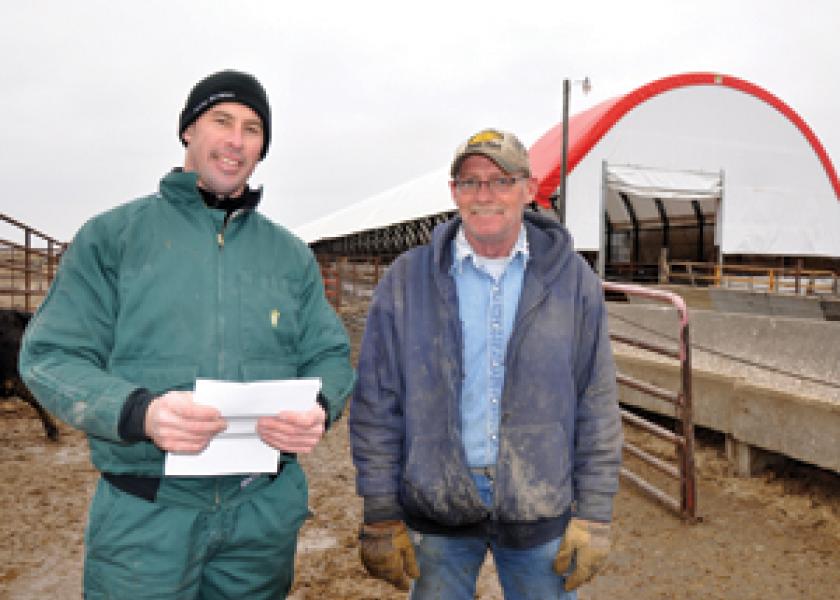Consider Timed AI for Quicker Cowherd Improvements

The goal of every breeding season is a bred heifer or cow. Estrous synchronization (ES) programs offer a good way to achieve a higher percentage of pregnant females with less labor and time spent on heat detection.
The purpose of ES is to control estrus (heat) and ovulation in cycling females in order to complete breeding in a shortened time period. ES programs prepare cattle for AI at a scheduled time. The main advantages of a timed-AI program is that all animals can be managed and bred in a group and that the labor and time needed to detect heat is reduced. However, skilled management and adequate facilities for handling are required. For best results, animals need to be in good body condition and health.
Several ES protocols are available. The primary groups of products to synchronize estrus and ovulation in beef cattle are: prostaglandins (PG), gonadotropin-releasing hormones (GnRH) and progestins.
Heifer replacement programs. "Beef producers have been reluctant to adopt estrous synchronization and AI methods because they think these technologies are too complicated or too costly," says David Patterson, University of Missouri professor of animal science and reproductive physiology.
Patterson concedes that until recently, achieving acceptable pregnancy rates with fixed-time AI was easier in beef cows than in heifers. His research focuses on developing a long-term protocol for beef heifers using controlled internal drug release (CIDR) devices. The protocol is referred to as the 14-day CIDR-PG protocol, or, in Missouri, "Show-Me Synch."
This ES protocol is used extensively in the Show-Me-Select Replacement Heifer Program that Patterson oversees. Since it started in 1997, the program has developed nearly 95,000 replacement heifers from more than 700 producers.
The Show-Me Synch protocol uses a CIDR that contains progesterone, which is used to synchronize estrus in cycling heifers and helps induce estrus in heifers that have not yet reached puberty.
The Show-Me Synch protocol is simple and starts with administering a CIDR device for 14 days. At 16 days after CIDR removal, heifers receive an intramuscular injection of PG that brings them into heat. Heifers are AI’ed 66 hours after the PG shot. At the time of AI, an injection of GnRH is given to induce ovulation.
Patterson says the program has had consistent results with the 14-day CIDR-PG protocol. Data collected on 2,656 heifers in several states shows a 65% pregnancy rate using the protocol. "That means that 65% of the heifers became pregnant on the first day of the breeding season with no heat detection involved," he adds.
"With the 14-day CIDR-PG protocol, pregnancy rates are expected to be higher because the estrous cycle is synchronized better than with short-term CIDR-based or MGA [melengestrol acetate]–based protocols," he says.
Getting heifers bred early in the season means they will have more time to recover after calving, which improves their chances of conceiving earlier in the subsequent breeding season. Other benefits of timed-AI are a concentrated calving period that results in a more uniform calf crop, producers needing to spend less time observing and assisting heifers during calving, and the ability to identify and use high-accuracy sires.
Another successful protocol. Veterinarian Brian Huedepohl uses a different ES protocol for the replacement heifer development program he started in 2002 in eastern Iowa. This year, about 260 heifers are in the January-to-August program at Mike Finnegan’s feedlot near Parnell, Iowa.
Huedepohl and his colleagues at the Veterinary Medical Center in Williamsburg, Iowa, use MGA, which is a progestin, and Lutalyse, a prostaglandin. Heifers are fed 0.5 mg of MGA per head per day for 14 days. Nineteen days after stopping the MGA, heifers are given a Lutalyse injection. After 66 hours, the heifers receive AI and an injection of Cystorelin, a GnRH product used to induce ovulation.
"We get about a 65% conception rate for the heifers with MGA. I think it’s because we can control the MGA consumption since all the heifers are bunk-fed. We make sure each heifer has plenty of bunk space to get her daily share of MGA," Huedepohl says.
"We haven’t used CIDRs because we can get similar conception rates with MGA. It saves an extra trip through the chute and we save on the cost of a CIDR, which is about $10, compared to MGA at about $1.50 per head," he says.
Regardless of which ES protocol is used, Huedepohl says, using superior genetics from proven sires is a major benefit of heifer development programs. "With AI, you can get the best genetics without the cost of keeping a bull," he adds.
Labor saver. Cattleman Chris Larkin of Ottumwa, Iowa, who is also a Genex Cooperative, Inc., representative, works with Huedepohl on the replacement heifer program. Larkin and his father, Pat, own 350 Angus-based cows that they AI each spring. For 21 days, older cows are observed for heat and AI’ed 12 hours later.
Heifers receive an MGA/Lutalyse protocol similar to Huedepohl’s. Yearling heifers are fed MGA for 14 days in dry lot in early spring. On day 33, they are given a PG injection of either Lutalyse or
Estrumate. They are AI’ed 48 hours to 72 hours later when a standing heat is observed.
"Heifers will have a heat cycle within a few days of stopping the MGA, but the first heat is not a very fertile one. That’s why we wait until day 33 to give the prostaglandin shot when the heifers are in their second heat. Our conception rates are about 62% to 66% with this system," Larkin says.
"More of our customers are using CIDRs to save time and labor. Some of them work during the week, so they put in a seven-day CIDR from Thursday to Thursday, then AI over the weekend. They’re done by Sunday night," Larkin says.
"CIDRs cost more per head than other ES protocols," he adds. "But if you get more cows bred faster and calves born earlier, you may make $50 more per calf at sale time."







